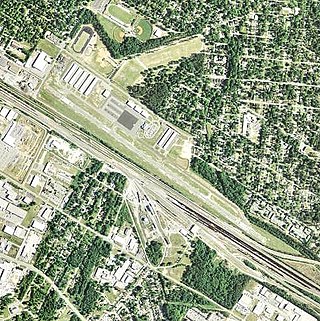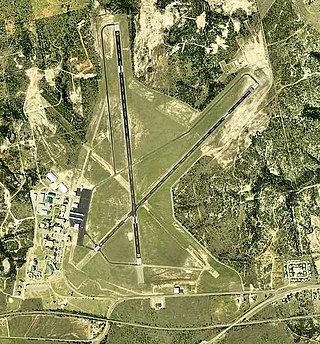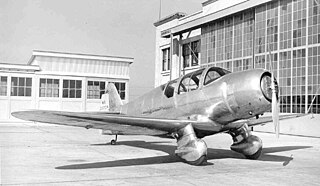Related Research Articles

The ERCO Ercoupe is an American low-wing monoplane aircraft that was first flown in 1937. It was originally manufactured by the Engineering and Research Corporation (ERCO) shortly before World War II; several other manufacturers continued its production after the war. The final model, the Mooney M-10, first flew in 1968 and the last model year was 1970. It was designed to be the safest fixed-wing aircraft that aerospace engineering could provide at the time, and the type continues to enjoy a faithful following.

Engineering and Research Corporation (ERCO) was started by Henry Berliner in 1930. Berliner was the son of Emile Berliner, who had patented numerous inventions relating to sound and acoustics, and pioneer of helicopter development with the experimental Berliner Helicopter.

Roosevelt Field is a former airport, located in Westbury, Long Island, New York. Originally called the Hempstead Plains Aerodrome, or sometimes Hempstead Plains field or the Garden City Aerodrome, it was a training field for the Air Service, United States Army during World War I.

Waco Regional Airport is five miles northwest of Waco, in McLennan County, Texas. It is owned by the City of Waco.

Bowman Field is a public airport five miles (8.0 km) southeast of downtown Louisville, in Jefferson County, Kentucky. The airport covers 426 acres (172 ha) and has two runways. The FAA calls it a reliever airport for nearby Louisville Muhammad Ali International Airport.

Henry Adler Berliner was a United States aircraft and helicopter pioneer.

Rockwell Field is a former United States Army Air Corps (USAAC) military airfield, located 1.1 miles northwest of the city of Coronado, California, on the northern part of the Coronado Peninsula across the bay from San Diego, California.

College Park Airport is a public airport located in the City of College Park, in Prince George's County, Maryland, United States. It is the world's oldest continuously operated airport. The airport is located south of Paint Branch and Lake Artemesia, east of U.S. Route 1 and the College Park Metro/MARC station and west of Kenilworth Avenue.

St. Louis Downtown Airport is a public-use airport located in Greater St. Louis, one mile (2 km) east of the central business district of Cahokia Heights, in St. Clair County, Illinois, United States. It is owned by the Bi-State Development Agency. The airport is located less than 3 miles from the Gateway Arch riverfront in St. Louis and is used by many business aircraft visiting the St. Louis region. Airport services include one full-service 24-hour fixed-base operator, an instrument landing system, an FAA air traffic control tower, and its own dedicated Index B aircraft rescue and firefighting (ARFF) service. It is utilized mainly by Saint Louis University's Parks College of Engineering, Aviation and Technology for training purposes, as well as the St. Louis Cardinals for charter flights to away games.

Middletown Regional Airport, also known as Hook Field, is a city-owned public-use airport located two nautical miles (3.7 km) north of the central business district of Middletown, a city in Butler County, Ohio, United States. The airport was renamed in October 2008; it was previously known as Hook Field Municipal Airport.

Jim Hamilton–L.B. Owens Airport, known locally as Owens Field, is a county-owned public-use airport located two nautical miles (3.7 km) south of the central business district of Columbia, in Richland County, South Carolina, United States. In 2008, the airport was renamed in honor of former airport manager Jim Hamilton. It was formerly known as Columbia Owens Downtown Airport.

Avenger Field is a Texas airport in Nolan County, three miles west of Sweetwater. The National Plan of Integrated Airport Systems for 2011–2015 called it a general aviation facility.
Parks College of Engineering, Aviation and Technology is a college within Saint Louis University. It formed from the pre-existing Parks Air College, founded by Oliver Parks in 1927.

Maryland's first aeronautical event was the flight of 13-year-old Edward Warren from Baltimore in Peter Carne's tethered hot air balloon in 1784.
Spartan College of Aeronautics and Technology (Spartan) is a private for-profit aviation college in Tulsa, Oklahoma. It was originally established to provide pilot and technicians for Spartan Aircraft Company but outlived its parent company and continues to train pilots and mechanics into the 21st Century. The main campus is adjacent to Tulsa International Airport, with another campus used for flight training at Richard Lloyd Jones Jr. Airport.
The Curtiss-Wright Technical Institute was an early professional trade school operated by the Curtiss-Wright corporation for aircraft maintenance training. Director Major C. C. Moseley was one of only three school directors selected across America to set the standards for the pre-World War II civilian pilot training program.

The United States capital, Washington, D.C., has been the site of several events in the nation's history of aviation, beginning from the time of the American Civil War, often for the purpose of promoting the adoption of new aeronautical technologies by the government. It has also been home to several governmental and civilian aircraft manufacturers and aviation organizations, and several aerospace contractors.
The Greater St. Louis Air & Space Museum is a museum with the mission to preserve and display historic air and space craft and artifacts, and provide educational programs.
Major William Bryan Robertson was an American aviator and aviation executive who was the co-founder of Lambert-St. Louis Flying Field as well as the owner and President of Robertson Aircraft Corporation (RAC) located there, a company which he had co-founded with his brother, Frank, in 1918.

The Boeing School of Aeronautics was a school that operated in Oakland, California from 1929 to 1945. It taught the design, maintenance, and flying of aircraft made by the Boeing Airplane Company. In its later years, the school was known as the United Air Lines Training Center.
References
- 1 2 3 4 5 Glenshaw, Paul (November 2013). "For a few magical years, it looked like every family would own an airplane". Smithsonian .
- ↑ "Gravois Company using plane to advertise Chevrolet". Globe Democrat. 9 May 1926.
- ↑ "Timeline of Saint Louis University". Saint Louis University. Retrieved 8 July 2020.
- ↑ The Army Air Forces in World War II, Volume Six Men and Planes. Washington, DC: U.S. Government Printing Office. p. 455. ISBN 091279903X.
- ↑ Gilbert Guinn. The Arnold Scheme: British Pilots, the American South and the Allies' Daring Plan.
- 1 2 3 4 5 6 7 8 9 10 11 "St. Louis Downtown Airport History". St. Louis Downtown Airport. Retrieved September 2, 2012.
- ↑ "Airport and Museum Building". Greater St. Louis Air and Space Museum. Retrieved September 2, 2012.
- ↑ Popular Science: 112. June 1944.
{{cite journal}}: Missing or empty|title=(help) - ↑ Barnes Warnock McCormick, Conrad F. Newberry, Eric Jumper, American Institute of Aeronautics and Astronautics. Aerospace engineering education during the first century of flight.
{{cite book}}: CS1 maint: multiple names: authors list (link)